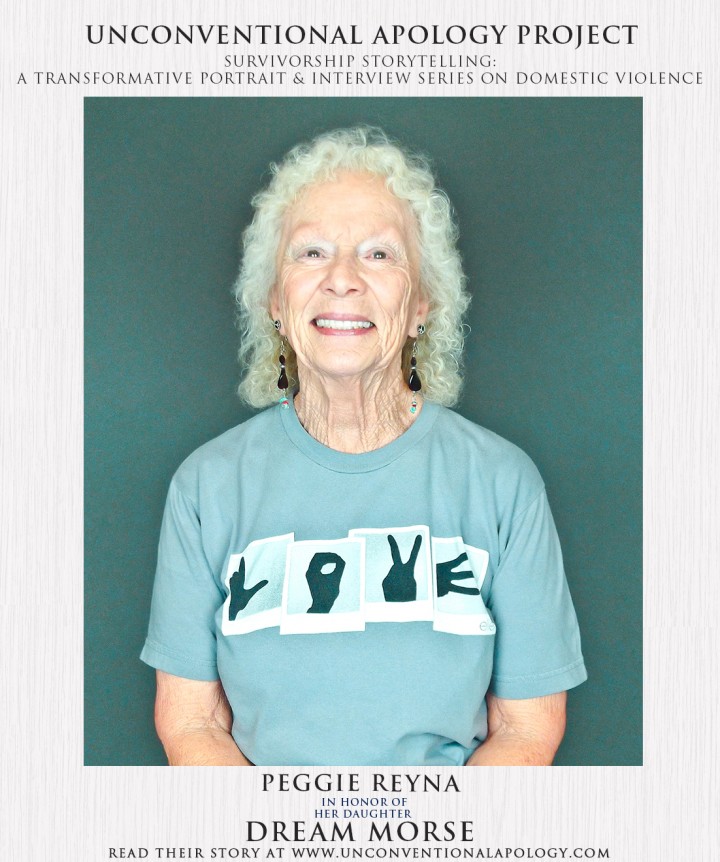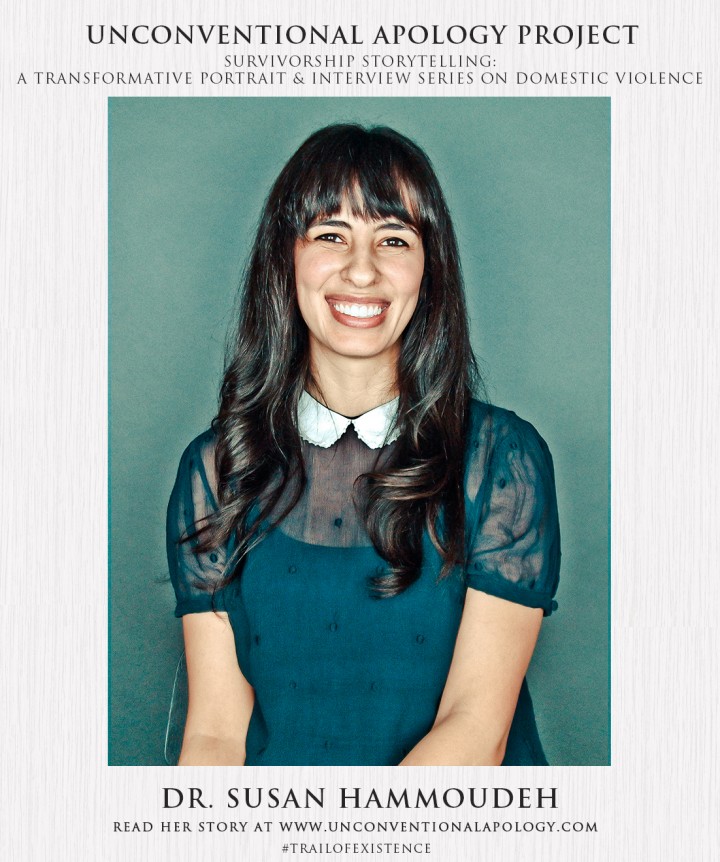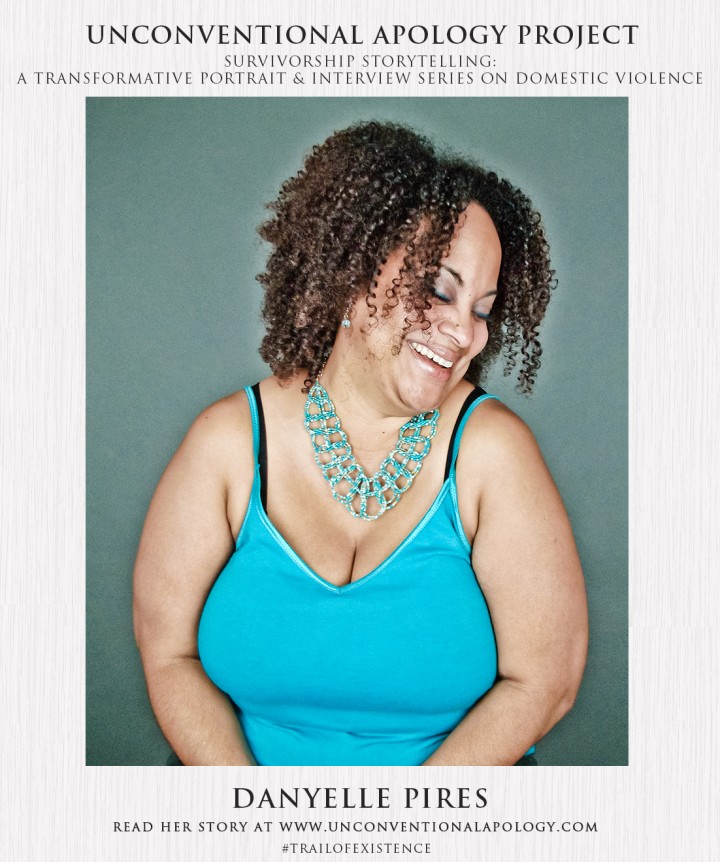Her tragically slain grandmother honored through a Trail of Existence, Los Angeles-based artist Chantal Barlow has carefully crafted a thoughtful project in her Unconventional Apology, inspiring many to come forward with their own powerful tales. Through this engaging series of portraits (taken with a very symbolic camera), Barlow gives a voice to a previously voiceless group. It is in this voice we find the strength to open up a dialogue on an uncomfortable topic. We need these conversations to be ongoing, but we need to open the eyes and ears of the majority of society who ignores the importance of such conversations.
from participant Tamieka Smith:
“When I told my story to some people, they said, ‘Oh. Well you don’t look like domestic violence.’ What does it look like? It doesn’t have an age requirement, skin tone, an intellectual requirement…at all. ”
It is in this declaration of solidarity, the project flourishes in its conquest to bring attention to a very serious issue plaguing our society. The conversation may be uncomfortable, and the apology dubbed unconventional, but the critical thought on the topic is vital.

Visibility is the best place to start on this issue, considering the current state, current opinions, and current lack of education surrounding domestic violence perception. There seems to be a familial cycle of violence, unbreakable and undeniable. The cycle needs to be broken, so the familiar denial can be deemed unacceptable. The apology may be unconventional, but that may be just what we need: distancing ourselves from convention. Chantal Barlow takes us through her current project, one that is personal in content yet universal in impact.
————————————————————————————————–
I consider myself to be a storyteller. Both of these endeavors allow me to use a different voice. Both paths are very connected to leaving a positive impact on the world. They are direct reflections of my personality, but the end points are the same. I just want to interject Light in any place that I can. This is especially crucial with Unconventional Apology Project, given that the topic itself is very dark and heavy. With that, I don’t consider Unconventional Apology Project to be a shift in focus, but more so a shift in a fossilized perspective I thought was very important to share.

Take us through the inception of the project…
The inception came very organically. I think it’s important to start from the beginning. My family carried a very dark secret that I was not aware of until I was about 16 years old. My grandfather murdered my grandmother, Mableine Nelson Barlow, 2 days after their divorce was final and in front of my father, who was 16 at the time. She was killed at age 36 after having had 7 children with her abuser. He was never punished for his crime and was able to live a full life until age 84.
The inner-conflict about the impact of domestic violence has never left me. To have a loving relationship with my grandfather at the time felt like I was being lied to by omission. I felt this sense of guilt and confusion that I didn’t have the opportunity to make a decision on my own about this particular relationship. One thing that always weighed heavily on me is the lack of celebration of my grandmother. We didn’t ever acknowledge her during holidays or her birthday. It was as if she didn’t exist. On the contrary, my grandfather had thousands of photos attached to his own existence being the family photographer. I was appalled that we only had 2 photos of my grandmother to mark her existence beyond her bloodline. When my grandfather passed away 2 years ago, he left me his camera. I knew shortly after that I was going to use it to make an impact. The portraits you see from Unconventional Apology Project are taken with his camera. The focus of the project is to honor my grandmother by showing her face and telling her story to develop her Trail of Existence, which we talk about in every participant’s interview. I’ve woven a lot of symbolism into the project to honor my grandmother’s life. Every participant wears blue, which was her favorite color. Even the number of portraits that will complete this series is a reference to her – 36, her age when she died. The Unconventional Apology is layered. It’s a societal apology for the way we treat victims of abuse, and it’s a family apology for being quiet about her death and not openly celebrating her life.
What happened to my grandmother, in terms of her life being swept under the rug, occurs often with instances of domestic violence, particularly against women. In the media, we can mostly see that their stories haven’t mattered. The conversations have always been about the male abusers having so much talent and being so charismatic and how they ruined it by hitting or killing their girlfriends, fiancées and wives. The conversation around the victims of violence focuses on all the ways the women mishandled their relationship. This is not a nurturing environment for women to feel like they will be supported if they step forward to share what happened to them. I wanted to shift that with this project and cultivate a safe space for the participants to step forward, face the camera and speak from the heart about what they went through, how it’s impacting them and where they’re headed in the future. These interviews are highlighting the reality of abuse and the reality of humanity. The participants are diverse in age, ethnicity, profession, and type of abuse they experienced. Every story is complex and relatable. When you look at the portraits, you see these women smiling, full of light and warmth and they look like people you know in your every day life. They’re your friends, coworkers, teachers, professors, doctors, lawyers, family members, etc. There is no (one) type of woman that experiences abuse. It can happen to anyone, and we should be there to support them if and when they need help.

Unconventional Apology has been ongoing for a year now. What impact do you feel that you’ve had and what’s happened to some of the participants as a result of your efforts?
Thankfully, the participants have been very vocal about their experience. It’s all been incredibly positive. The messages have been related to healing and moving forward. Each and every participant has such a connection to the idea of making an impact on another Soul. They truly want their stories to shift the dialogue on domestic violence. One of the themes of post-participation is “shedding,” the release of finally being able to speak on something that they’ve never had a chance to share in this way. Often times, victims of domestic violence share their stories in defense: of themselves and in response to accusations of their stories being untrue or responding to someone highlighting all the mistakes they made (a la “why I stayed”). For all of them, this has been a very public way of “coming out” on their experience. It’s self-serving in the short term, but all participants are contributing to the volume of the collective voice on this matter. It’s incredibly motivating, connecting and I’m eternally grateful for their bravery.
How has your family received the project? Are they supportive of you and the family connection to the project?
Before I started the project, I shared it with my mom. I wanted to use her as a sounding board since she is the glue for our family. Her perspective was really important to me since she is my father’s partner; her insight would be greater than anyone’s. I didn’t bring it to my father first, because I wanted to be sure that I articulate the idea thoroughly before I brought it to him. I wanted to be careful and sensitive to his feelings. My mom was very encouraging, and it made it a lot easier to speak to my dad about the project. He took it all incredibly well. He’s shared that it’s been a very healing experience for him. Something as simple as using her name in a conversation, or referencing her favorite flower is a complete 180 from the non-existent dialogue about her. This is one of the greatest feelings in the world. For me, this is what Art is about.
Can this project be a real first step in ending the patriarchal-normative narrative that rules this country and its powers that be when it comes to domestic violence (and other issues, tbh)?
I can only hope so! I think that gaining further visibility on the victims (be it any sex, or sexual identification) is truly important. Most people don’t connect with numbers/statistics. That’s why the photos are head-on, face first. It forces you to look into the eyes of these incredible people. I think the patriarchal-normative narrative will be long lasting due to current social norms that are tied to founding Christian beliefs, especially in certain parts of the United States. It’s all very layered, and the project is trying to peel all of this back one story at a time.

Explain your feelings on the gender double standard that exists when speaking of male on female violence vs. female on male violence?
This comes up a lot. I often get asked “why not men?” There is absolutely domestic violence/intimate partner violence where men are the victims. This is actually part of a series that will come out in time. Physiologically speaking, sometimes men can have the upper hand, so some parts of society have less compassion for those men experiencing domestic violence. The reality is that domestic violence comes in many forms, not just physical. DV or IPV of any kind is very painful for any victim no matter the pronoun someone identifies with.
Somewhat to that point: any domestic violence statistics that you’re aware of in the gay community? With the recent legalization of marriage for all 50 states, it strikes me as…let’s say… interesting that it’s been illegal for so long for people who just want to love one another (read: the whole point of marrying someone in the first place, duh) while the hetero community destroys the sanctity of marriage with skyrocketing divorce rates and instances of domestic violence (among other issues). I don’t know, to me the mainstream world is f***ed, but I’m interested to hear your take on my little mini “rant”…
The issue with domestic violence and IPV is that it’s under-reported in any type of relationship. Statistically speaking, the debate right now is whether the likelihood of women experiencing domestic violence is 1 in 4 or 1 in 3 women. In terms of same-sex IPV, simply being in a same-sex relationship also remains under-reported let alone same-sex instances of domestic violence. The current statistics still aren’t concrete enough to make clear lines in the sand about what’s happening behind closed doors. There seems to be an air around it not being “as serious,” or it’s somehow an even “fight” because it’s same-sex. These perspectives are really dangerous, and completely unfounded; but I hear it all the time from all sides. There is a lot to address. Visibility is a good place to start.